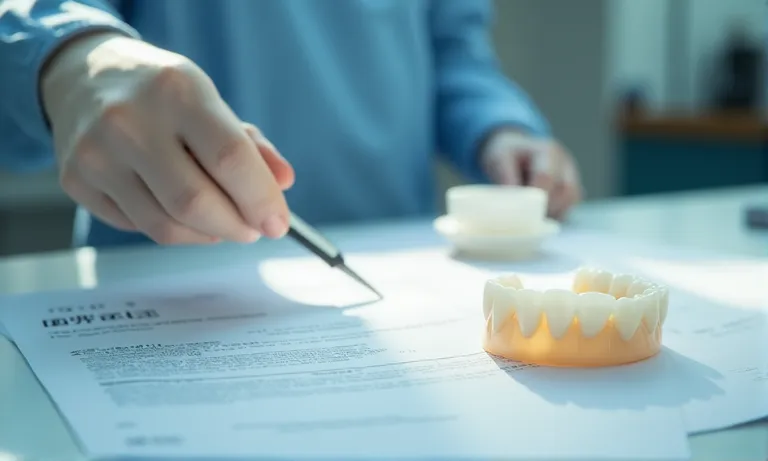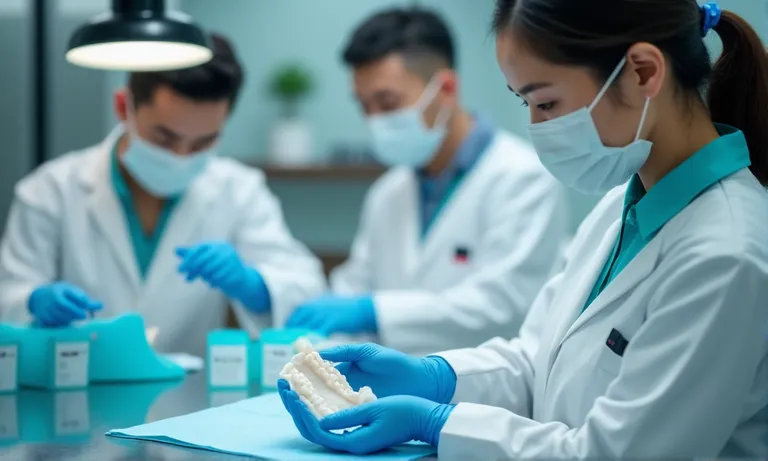Zirconia veneers are gaining global popularity—but that doesn’t mean all are approved for use.
In the US and Europe, strict regulatory requirements govern which zirconia materials can be used clinically.
This article explains how CE marking, FDA clearance, and ISO compliance affect your ability to deliver safe, legal, and fully traceable restorations.
Zirconia veneers are clinically approved for use in the US and Europe when made from certified materials that meet FDA 510(k) requirements, carry CE marking under MDR regulations, and comply with ISO quality standards.
Clinical Certifications Required for Zirconia Veneers in the US and EU
For any zirconia veneer to be legally placed in the US or EU, it must meet specific regulatory certifications ensuring its safety, performance, and traceability. As a dental lab serving international markets, understanding these compliance layers is essential—not only for import legality but also for clinician and patient trust. Certification isn’t just paperwork; it’s the foundation of clinical legitimacy.

Image
ALT: Zirconia-veneer-certification-FDA-CE-ISO
Prompt: Realistic tabletop layout of a zirconia block, CE and FDA approval papers, ISO badge icon, and dental veneer sample; clinic background, soft lighting emphasizing documents and material.
CE Marking Requirements for Dental Ceramics
In the European Union:
- Zirconia veneers must be made from CE-marked Class IIa medical devices (under MDR 2017/745)
- Manufacturers must provide:
- Technical file with performance data
- Risk analysis and biocompatibility tests
- Declaration of Conformity (DoC)
A CE-marked zirconia block confirms its use is approved across all EU and EEA states.
FDA 510(k) Clearance and Class II Classification
In the US:
- Zirconia materials used for fixed restorations fall under Class II dental devices
- To be legally marketed, they must have:
- FDA 510(k) clearance, showing substantial equivalence to a legally marketed predicate
- Device listing number and manufacturer registration
- This applies to zirconia blocks, discs, and some pre-sintered forms
Labs using non-listed zirconia risk violating federal law—even if the block performs well clinically.
ISO 6872 and ISO 13485 Overview
- ISO 6872 defines minimum performance standards for dental ceramics:
- Flexural strength
- Translucency
- Biocompatibility
- ISO 13485 governs medical device quality management systems, often required for CE/MDR approval
Certified zirconia should reference compliance with both standards in its material documentation.
Regional Labeling and Compliance Expectations
To pass customs or audits:
- EU: must include UDI (Unique Device Identifier) and traceable CE mark
- US: must provide 510(k) number and labeling consistent with approved use
- Distributors must translate documentation where required (e.g., France, Germany)
Labs should retain all certification files for at least 10 years post-manufacture.
✅ Zirconia veneers require CE or FDA certification before clinical use in Europe or the US – TRUE
Both regions classify zirconia as a regulated medical material requiring documentation and market approval.
❌ All zirconia on the market is pre-certified and ready for veneer use – FALSE
Only zirconia blocks with traceable certification and documented compliance are legally approved for clinical application.
Clinical Approval and Market Use of Zirconia Veneers in the US and EU
Zirconia veneers are widely accepted and used across both the United States and European Union—but only when sourced from certified, traceable materials. Clinical approval is not just about raw zirconia composition; it’s about what documentation, processing standards, and labeling come with the final product. From the lab perspective, we ensure not only material quality but also transparency for our clinic partners.

Certified-zirconia-veneer-usage-EU-US
Common Brands with FDA and CE Approval
Zirconia materials used for veneers must originate from:
- Reputable manufacturers with FDA 510(k) and CE Marking
- Examples include:
- Ivoclar Zenostar
- Aidite 3D Pro
- Kuraray Noritake Katana
- 3M Lava Plus
These materials undergo clinical testing and device equivalency review before being approved for veneer applications.
Documentation Supplied with Certified Blocks
Certified blocks should include:
- Batch-specific Certificate of Conformity (CoC)
- 510(k) or CE number on label or inside package
- Material safety data sheets (MSDS) with biocompatibility info
- Manufacturer’s UDI or lot code
At Raytops, we log and verify each block’s certificate before production and archive it per regulatory timelines.
Distinctions Between Lab-Certified vs. Raw Material Certified
- Some vendors offer “lab-certified” veneers—this often means only the lab follows QA protocols, not that the material itself is CE/FDA approved
- What matters:
- Is the block certified?
- Is the processing workflow validated under ISO 13485?
If only the lab has ISO certification but uses non-listed zirconia, regulatory risk remains high.
Market Usage Data Across US and Europe
- Zirconia veneers now make up a growing share of:
- Full-arch esthetic rehabilitations
- High-strength anterior cases
- Posterior esthetic zones with occlusal load
- Usage is growing fastest in:
- Germany, Spain, Poland (EU)
- California, Texas, Florida (US)
Certified zirconia is no longer niche—it’s mainstream in the right clinical categories.
Zirconia veneer materials are widely accepted—but only when backed by proper documentation. Labs and clinics alike must verify that certification applies to the material used, not just the lab itself. That distinction often separates compliant restorations from regulatory risk.
Manufacturing Standards for Zirconia Veneer Quality and Safety
The quality and safety of zirconia veneers start long before a case reaches the clinic—it begins at the raw material stage and continues through every step of processing. While many zirconia blocks may appear similar, only those made under strict manufacturing controls ensure long-term biocompatibility, structural integrity, and color stability. From the dental lab’s perspective, these differences directly impact fit accuracy, veneer survival, and patient safety.

Zirconia-manufacturing-standards-veneer-safety
Sintering Controls and Structural Integrity
- Medical-grade zirconia requires high-purity powder and controlled particle size
- Consistent sintering curves (temperature, duration, atmosphere) affect:
- Final grain structure
- Flexural strength
- Marginal fit during milling and seating
Inconsistent sintering may result in chipping, warping, or internal microcracks, especially at thin veneer margins.
Biocompatibility and Cytotoxicity Testing
- All dental zirconia must pass ISO 10993-5 biocompatibility protocols:
- Cytotoxicity
- Irritation and sensitization
- Genotoxicity (if colored with pigments)
Only tested and documented materials should be considered for restorations that contact soft tissue or pulp-adjacent surfaces.
Traceability from Material to Patient
- Certified blocks include:
- Lot number or UDI
- Manufacturer code
- Date of manufacture and expiration (if applicable)
- These identifiers ensure traceability in:
- Lab QA logs
- Distributor batch reporting
- Post-market surveillance or recall situations
Labs must maintain these records for at least 10 years, per MDR and FDA expectations.
Colorant Safety and Stability
- Pigments added during block production (for A–D shades or multilayer effects) must be:
- FDA/CE approved for intraoral use
- Non-leachable, thermally stable, and non-cytotoxic
- Poor-quality pigments can discolor, degrade in sintering, or leach into oral tissue
✅ Certified zirconia blocks must follow strict sintering, biocompatibility, and pigment safety protocols – TRUE
These controls ensure not just clinical strength, but safe, traceable, and durable veneer outcomes.
❌ All zirconia materials on the market meet the same safety standards – FALSE
Only properly regulated manufacturers follow ISO 13485 and validate their material processes under CE or FDA oversight.
Risks of Using Non-Certified Zirconia Veneers in Clinical Practice
Not all zirconia is created—or certified—equally. Using non-certified zirconia in the US or EU carries legal, financial, and clinical risks that far outweigh any short-term cost advantage. From a dental lab’s experience, uncertified materials are one of the top causes of remakes, audit failures, and brand-damaging patient complaints. These risks extend across the entire treatment chain—from manufacturer to distributor, lab, and clinic.

Non-certified-zirconia-clinical-risk
Clinical and Regulatory Risk Factors
| ⚠️ Risk Area | Impact on Practice | Common Triggers |
|---|---|---|
| Patient Injury | Allergic reaction, fracture, implant failure | Pigment leaching, sintering voids |
| Legal Liability | Lawsuits, dental board action | No documented FDA/CE clearance |
| Insurance Denials | No reimbursement or pre-authorization | Non-listed material used |
| Customs Seizure | Loss of shipment, investigation | Missing UDI or CE documentation |
| Clinical Remakes | Increased lab costs, trust loss | Marginal integrity, debond, esthetic failure |
We’ve seen cases where veneer batches were held at EU customs simply due to incorrect CE labeling—despite being from reputable labs.
Common Misconceptions vs. Regulatory Reality
| ❌ Misconception | ✅ Reality |
|---|---|
| “If the lab is ISO certified, the materials must be too.” | ISO 13485 applies to process, not necessarily the raw material. |
| “Zirconia is biocompatible by nature—it doesn’t need approval.” | Only zirconia tested under ISO 10993 and listed with FDA/CE is approved. |
| “If it looks good and mills well, it’s fine to use.” | Performance does not replace legal traceability and certification. |
✅ Non-certified zirconia veneers expose clinics and labs to legal, financial, and clinical failure – TRUE
Without FDA/CE documentation, the burden of liability falls squarely on the provider—regardless of clinical result.
❌ All zirconia behaves the same, so certification is optional – FALSE
Material origin, pigmentation process, and biocompatibility documentation determine whether it’s legally usable in patient care.
How Clinics and Labs Can Confirm Zirconia Veneer Certification
Ensuring the zirconia used in veneer cases is truly certified doesn’t need to be complex—but it does require consistency and documentation. For clinics, labs, and distributors, building a simple verification process protects against regulatory fines, insurance denials, and clinical complications. At Raytops, we embed these checks into every case we ship—so our partners don’t have to second-guess what they’re delivering.

Zirconia-certification-verification-lab-clinic
Request CE/FDA Documentation from Suppliers
- Ask for:
- CE Certificate of Conformity (DoC)
- FDA 510(k) Summary Sheet
- ISO 13485 manufacturing audit report
- Reputable suppliers should provide these without delay or resistance
Avoid distributors who respond vaguely or blame upstream manufacturers for missing files.
Check Lot Numbers and Manufacturer Labels
- Certified zirconia blocks must include:
- Lot number
- UDI (Unique Device Identifier)
- Manufacturer name + origin
- These must match:
- What’s on the CE/FDA file
- What appears on your case invoice or shipment
Any mismatch is a red flag—and grounds for return or escalation.
Maintain Certification Logs for QA
- Set up a shared log (e.g., Google Sheet or clinic software):
- Date of receipt
- Block type and code
- Certificate snapshot
- Who verified it
- Required under MDR (EU) and Good Manufacturing Practice (US) if audited
Labs using Raytops receive a digital certification packet with each case upon request.
Partner Only with Reputable Distributors
- Verify that your lab or supplier:
- Publishes material origin clearly
- Provides documentation by case or lot
- Operates under ISO or FDA-registered workflows
If unsure, ask for a “compliance kit”—a bundle of current documents to validate the materials in use.
Traceability and certification aren’t a burden—they’re protection.
Want a certification checklist or need help reviewing zirconia block documentation? Our team can assist with sample validation, CE/FDA cross-checks, and building your clinic’s compliance log.
Conclusion
Zirconia veneers are a trusted material in modern restorative dentistry—but only when certified and traceable. Understanding the regulatory requirements behind FDA clearance, CE marking, and ISO compliance protects your practice, your patients, and your lab reputation.
- Zirconia veneer approval: Overview of how clinical use is governed by FDA, CE, and ISO.
- Zirconia certifications: Materials must be classified and cleared before use in US/EU.
- Zirconia market usage: Certified zirconia is now widely used in full-arch and anterior cases.
- Zirconia manufacturing: Quality begins at the raw material and sintering control level.
- Zirconia risks: Non-certified materials pose legal, financial, and patient care dangers.
- Zirconia verification: Labs and clinics can confirm certification with simple documentation checks.
Need help reviewing a supplier’s certification or building a compliance log? Contact Raytops Dental for CE/FDA templates, block verification support, or a sample traceability workflow.


